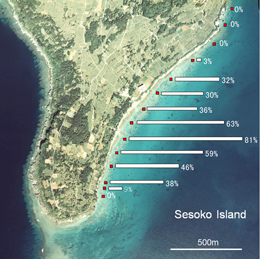Research Abstract
コモンサンゴに付着する珪藻類の低温ストレスによる局所的大発生
Localized outbreak of attached diatoms on the coral Montipora due to low-temperature stress
2012年8月1日 Scientific Reports 2 : 552 doi: 10.1038/srep00552

2011年2月、沖縄の瀬底島の近海で、生きているサンゴに珪藻類が付着して、短期間ながら局所的に大発生する現象が発見された。初期に褐色の斑点のように見える珪藻は、綿毛のようにサンゴを覆うようになり、サンゴの全体または一部が死に至った。付着珪藻類(Licmophora、Climacosphenia、Ardissoneaなど)は、瀬底のサンゴ礁の一部を優占するコモンサンゴ(Montipora)のみに付着し、これを覆うほど増殖した。覆われ方の激しい群体や枝は死に至った。区域によっては、被害を受けたサンゴが80%に達した。顕微鏡観察の結果、珪藻の多くがサンゴ枝の部分的に露出した骨格に多糖の柄で直接付着している一方、一部はサンゴの軟組織に付着していることがわかった。国内のほかの海域では同様の現象の報告例がないが、急激な海水温の低下がサンゴの衰弱を引き起こし、その結果としてサンゴに珪藻類が付着し、この海域のサンゴを死に至らしめている可能性がある。
山城 秀之1, 三瓶 ゆりか2 & 鈴木 秀和2
- 沖縄工業高等専門学校 生物資源工学科
- 東京海洋大学 大学院海洋科学技術研究科
A short-term, localized outbreak of diatoms attached to live corals was observed along the coast of Sesoko Island, Okinawa, Japan in February, 2011. Diatoms are recognized as brown patches in the initial stage, becoming fluffy encrustations and resulting in complete or partial coral death. Attached diatoms, including Licmophora, Climacosphenia, Ardissonea and others, attached and overgrew exclusively Montipora corals, which are dominant corals in some parts of Sesoko reef. Heavily-covered colonies or branches died. The rate of affected corals reached 80% in the worst-affected area. Microscopic observation showed that most diatoms settled directly with polysaccharide stalks or pads onto the partly-bared skeleton of coral branches, although some settled on coral soft tissues. Although no similar phenomenon was reported from other areas of Japan, cold-water events might have important roles in coral weakening, as a consequence, enabling diatom attachment on corals, thus leading to coral death in this area.

